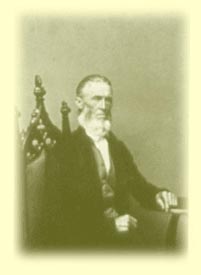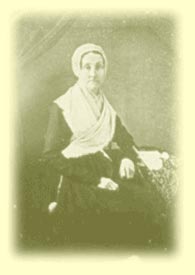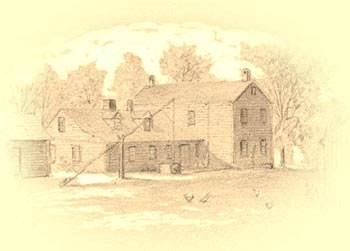Our coverage of the Champlain Line of the UGRR would be incomplete if we did not include Western Vermont. The terrain of the Green Mountain state along Lake Champlain was easy to traverse, and there was an early rail line connecting Albany and Troy to Rutland, Burlington, and St. Albans, Vermont. Plattsburgh and Albany were not connected by rail until after the Civil War. Many freedom seekers who went to Vermont from Albany, Troy and Boston, were forwarded across Lake Champlain to New York where they continued their journey to Canada West.
St. Albans

UGRR stationmaster Lawrence Brainerd,
who employed Mr. Boggs
Jeremiah C. Boggs
When Jeremiah C. Boggs arrived in St. Albans in 1843, businessman Lawrence Brainerd, who had a general store, welcomed him into his home and gave him a job. Boggs had been forwarded to St. Albans from Albany, New York. It had taken him three weeks to reach Albany from Richmond, Virginia. The Eastern New York Anti-Slavery Society reported Boggs's case in its annual report. Jeremiah had been sold six times. One of his masters, Joshua S. Green, had "treated him very bad." Jeremiah had fallen asleep one night from "excessive fatigue" while watching a piece of meat cook. When the fire burned the meat, his mistress beat him with a broomstick. Then her husband struck Jeremiah with his cane and stabbed him with a dagger in his hand, his thigh and under his ribs, "all at one time, swearing in the meantime he would kill him." The Greens starved Boggs to the point that he was forced to pick bits of table scraps out of a swill barrel of garbage they saved for their hogs. When the Greens caught Jeremiah with any garbage, they took it from him and whipped him.
When the abolitionists looked at Boggs they did not see a thief. They saw an intelligent, "mild pleasant man, and to all appearances a disciple of Christ." They noted that he was a Free Will Baptist. They described him as 30 years old, and about 5 feet 8 inches tall and pointed out that he had a brother in Montpelier, Vermont. That is very likely the reason he went to the Green Mountain State instead of Canada. In Albany, members of the Eastern New York Anti-Slavery Society "gave him some cash, a letter recommending him to the good, and sent him on."
But Boggs would soon find that he could not stay in Vermont. Toward the end of 1844, A.G. Tarlton, a townsman of St. Albans who knew his master, recognized Boggs. When an agent for the American Colonization Society came to town, Jeremiah followed him to Liberia, West Africa. He left "behind him the reputation of being a giant in strength and a faithful laborer."
In 1895, Lawrence's son, Aldis, had this to say about Jeremiah C. Boggs: "During his stay with us he learned to read and write and after landing in Africa sent my father a grateful letter informing him of his safe arrival." Aldis said Boggs escaped from South Carolina, but the Eastern New York Anti-Slavery Society said he escaped from Virginia, and that is probably the more accurate account because it was written less than a month after his escape.
Sources:
Annual Report of the Committee , Albany: Eastern NY A.S. Society & Fugitive Slaves, September 29, 1843. American Antiquarian Society.
Lawrence Brainerd image courtesy Ohio Historical Society
Ferrisburgh

Rowland Thomas Robinson, a leader of the anti-slavery movement
in Vermont and UGRR Stationmaster in Ferrisburgh

Rachel Gilpin Robinson
When the Quaker UGRR agent, Stephen Keese Smith of Peru, New York, shared his recollections in 1887, he identified a fellow member of the Religious Society of Friends, Rowland Robinson, as the principal agent in Ferrisburgh, Vermont. Smith recalled,
Many Negroes were run up on the other side of the lake to Canada. Rowland Robinson of Ferrisburgh, Vermont was the champion there. Scores of slaves made their escape through him. He ran his Negroes through to Canada mostly on the other side of the lake. There were also agents in Canada who got places for the escaped Negroes.

The Robinson's home, now Rokeby Museum, is a National Historic
and a National Park Service Network to freedom site.
In 1837, Oliver Johnson, a fellow Vermonter who was living in Pennsylvania at the time, wrote to Robinson about a fugitive slave named Simon who he thought Robinson might like to employ on his farm, Rokeby:
I saw yesterday, in this township a stout man who ran away from Maryland. He is 28 years old, and appeared to me to be an honest, likely man. He says he was sold with several others to a soul-driver for $1,000; consequently he must have been considered very valuable. When he came here...he was destitute of decent clothing, and unable to proceed, as he intended when he left Maryland, to Canada. A man in this place by the name of William C. Griffith, the son of a Friend, who has often rendered assistance to runaways kindly offered to keep him until spring. A reward of $200.00 has been offered for his apprehension, and it is not considered safe for him to remain here after winter has gone by...I was so well pleased with his appearance, and with the account given of him by Griffith, that I could not help thinking he would be a good man for you to hire. Mr. Griffith says he is of a kind disposition, and knows how to do all most all kinds of farm work. He is used to teaming, and is very good to manage horses. He says that he could beat any man in the neighborhood where he lived, in Maryland, at mowing, cradling, or pitching. He has intended going to Canada in the spring, but says he would prefer to stay in the U.S., if he could be safe. I have no doubt he would be perfectly safe with you. Would you not like to have him go to you in the spring? I fear that, if he goes to Canada, he may fall into bad company; but if he is under your guardianship, I think he may become a useful man...It will be a great way for him to walk, but not worse than going to Canada. He can be furnished with the names of abolitionists on whom to call upon the way, and I think may reach Vermont in safety.
When Robinson responded positively to Johnson's proposal, Johnson replied,
Immediately after receiving your letter, I wrote to Wm. C. Griffith of Jenner, the man with whom Simon was living, telling him to send the man to you as soon as he could be got ready for the journey. I gave him such directions as will enable him to reach Philadelphia, where he will put himself under the direction of our friends, who will give him all needful information concerning the route to New York, at which last place he will be befriended by the "Committee of Vigilance," or by members of the Ex. Committee. I trust he will meet with no serious difficulty on the way. He appeared to me to be a man of considerable perseverance, and I trust he will not be discouraged though it is a long way to your residence.
Another story of a fugitive slave from Maryland provides us with a link between Rowland T. Robinson and Peru, New York, where Robinson's fellow Quaker, Samuel Keese, was head of the UGRR depot.
The story comes to us from a letter Rowland T. Robinson's son, Rowland E. Robinson, wrote to the prominent UGRR historian Wilbur Siebert on August 19, 1896. Rowland E. reported,
Mariah Rogers, sister of Joseph, and his housekeeper, mentions in a diary kept from 1842 to 1846, that a fugitive was brought to their house by my father, and sent from there to McNeils ferry in Charlotte, and down the other side of the lake toward Canada, but I do not know to whom in that direction, unless Samuel Keese of Peru N.Y. who was in sympathy with the Antislavery workers.
Wilbur Siebert transcribed the above passage incorrectly because Rowland E. Robinson was nearly blind and his penmanship was extremely difficult to decipher. In his Vermont's Anti-Slavery and Underground Railroad Record With a Map and Illustrations (1937), Siebert said the young man was sent to "Samuel Parr of Peoria, N.Y."
But there was no one named Samuel Keese in a place called Peoria on the western side of Lake Champlain. We corrected Siebert by obtaining a digitized copy of Rowland E. Robinson's original letter from the Wilbur Siebert Collection at Harvard University's Houghton Library and zooming in on the questionable passage.
As we researched this story we learned that Rowland E. Robinson did not tell Siebert the entire story. We visited Rokeby Museum where Executive Director Jane Williamson showed us Mary Rogers's diaries, and we discovered that on November 11, 1844, Mary wrote,
...First day north wind ...there was a collored boy who said that he was seventeen years old came here said he came from Maryland state was going to Canada and his Master was after him and had traveled two nights and R.T. Robinson thought it would be best for him to come here and stay all night and he would come up in the morning which he did and directed him to Isaac Orvis in upper Canada and to cross the lake at McKneels..."
The McNeil ferry operated between Charlotte, Vermont, and Essex, New York. Isaac Orvis was a Quaker from Vermont who moved to Upper Canada where he became a member of the Yonge Street Meeting at Toronto. Swathmore College's Christopher Densmore provided us with confirmation that Isaac Orvis was a member of the Yonge Street meeting before his disownment in July of 1839. Orvis had struck a person in anger with the handle of an ax, and then used profane language on several people [presumably either the overseers or a committee from the Preparative Meeting] who visited him.
This groundbreaking research provided us with our first documented historical record of an UGRR route which linked Ferrisburgh, Vermont to Peru, New York, and Toronto, Canada.
For more information on the history of the Underground Railroad at Rokeby, contact Jane Williamson, Director, Rokeby Museum, 4334 Route 7, Ferrisburgh, VT 05456, (802) 877-3406 or rokeby@comcast.net.
Sources:
Mary Rogers's 1844 diary, Rokeby Museum.
Rowland E. Robinson, to Wilbur Siebert. Wilbur Siebert Collection at Houghton Library, Harvard College Library.
Rowland Thomas Robinson, Rachel Gilpin Robinson and Rokeby images, courtesy Rokeby Museum.
Wilbur Siebert, Vermont's Anti-Slavery and Underground Railroad Record With a Map and Illustrations (1937)






